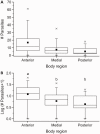Nematodes infect, but do not manipulate digging by, sand crabs, Lepidopa benedicti
- PMID: 24916475
- PMCID: PMC4097115
- DOI: 10.1093/icb/icu064
Nematodes infect, but do not manipulate digging by, sand crabs, Lepidopa benedicti
Abstract
We examined sand crabs (Lepidopa benedicti) for endoparasites, and found the only parasite consistently infecting the studied population were small nematodes. Because many nematodes have complex life cycles involving multiple hosts, often strongly manipulating their hosts, we hypothesized that nematodes alter the behavior of their sand crab hosts. We predicted that more heavily infected crabs would spend more time above sand than less heavily infected crabs. Our data indicate infection by nematodes was not correlated with duration of time crabs spent above sand. We also suggest that organisms living in sandy beaches may benefit from relatively low parasite loads due to the low diversity of species in the habitat.
© The Author 2014. Published by Oxford University Press on behalf of the Society for Integrative and Comparative Biology.
Figures







Similar articles
-
Filtering out parasites: sand crabs (Lepidopa benedicti) are infected by more parasites than sympatric mole crabs (Emerita benedicti).PeerJ. 2017 Sep 22;5:e3852. doi: 10.7717/peerj.3852. eCollection 2017. PeerJ. 2017. PMID: 28951818 Free PMC article.
-
Parasite infection and sand coarseness increase sand crab (Emerita analoga) burrowing time.Behav Processes. 2011 Nov;88(3):184-91. doi: 10.1016/j.beproc.2011.09.004. Epub 2011 Sep 28. Behav Processes. 2011. PMID: 21959036
-
Digging in sand crabs (Decapoda, Anomura, Hippoidea): interleg coordination.J Exp Biol. 1997;200(Pt 4):793-805. doi: 10.1242/jeb.200.4.793. J Exp Biol. 1997. PMID: 9318562
-
Olfactory circuits and behaviors of nematodes.Curr Opin Neurobiol. 2016 Dec;41:136-148. doi: 10.1016/j.conb.2016.09.002. Epub 2016 Sep 23. Curr Opin Neurobiol. 2016. PMID: 27668755 Free PMC article. Review.
-
Mechanisms of host seeking by parasitic nematodes.Mol Biochem Parasitol. 2016 Jul;208(1):23-32. doi: 10.1016/j.molbiopara.2016.05.007. Epub 2016 May 17. Mol Biochem Parasitol. 2016. PMID: 27211240 Free PMC article. Review.
Cited by
-
Filtering out parasites: sand crabs (Lepidopa benedicti) are infected by more parasites than sympatric mole crabs (Emerita benedicti).PeerJ. 2017 Sep 22;5:e3852. doi: 10.7717/peerj.3852. eCollection 2017. PeerJ. 2017. PMID: 28951818 Free PMC article.
References
-
- Anantaraman S, Subramoniam T. On a microphallid metacercaria occurring in the ovaries of the sand crabs Emerita asiatica and Albunea symnista on the Madras coast. Proc Indian Acad Sci. 1976;84B:192–9.
-
- Boschma H. The species of the genus Sacculina (Crustacea Rhizocephala) Zool Meded. 1937;19:187–328.
-
- Boyko CB. A worldwide revision of the recent and fossil sand crabs of the Albuneidae Stimpson and Blepharipodidae, new family (Crustacea, Decapoda, Anomura, Hippoidea) Bull Am Mus Nat Hist. 2002;272:1–396.
-
- Boyko CB. New records and taxonomic data for 14 species of sand crabs (Crustacea: Anomura: Albuneidae) from localities worldwide. Zootaxa. 2010;2555:49–61.
Publication types
MeSH terms
Grants and funding
LinkOut - more resources
Full Text Sources
Other Literature Sources

